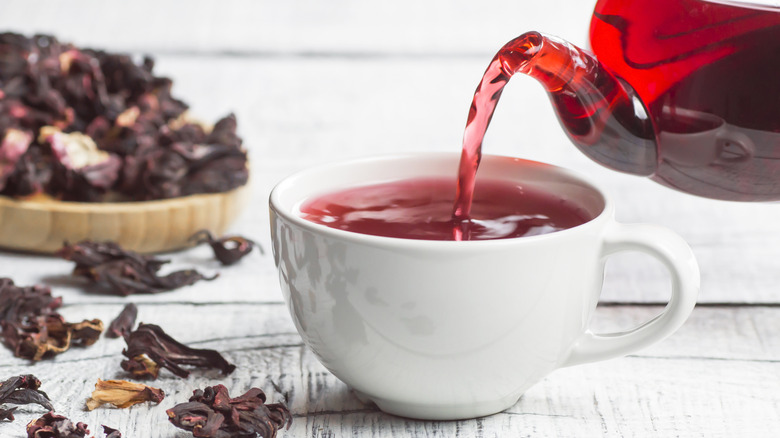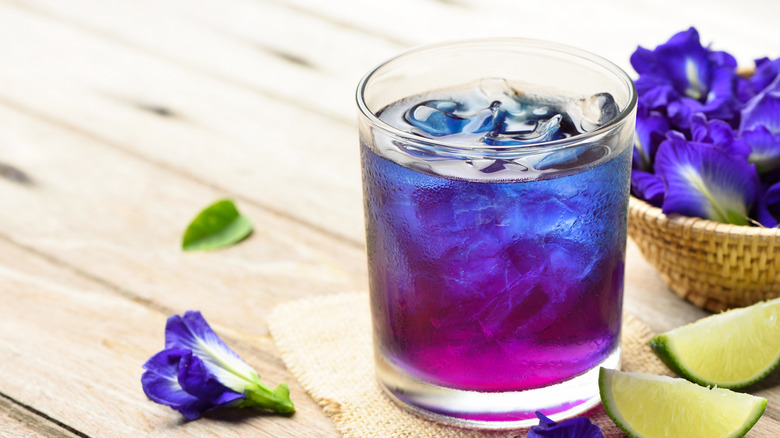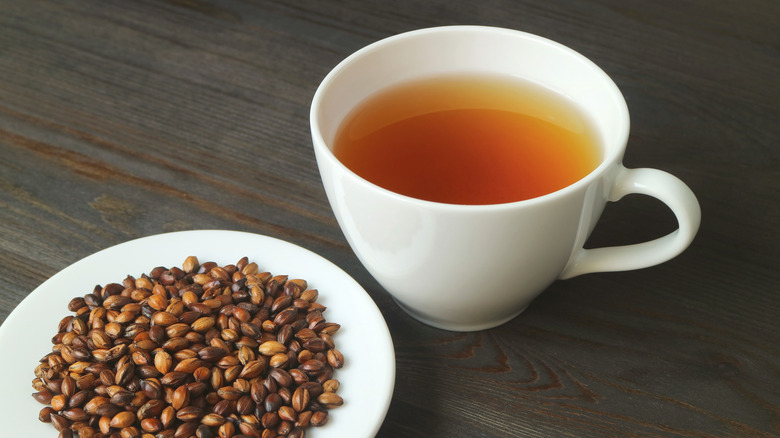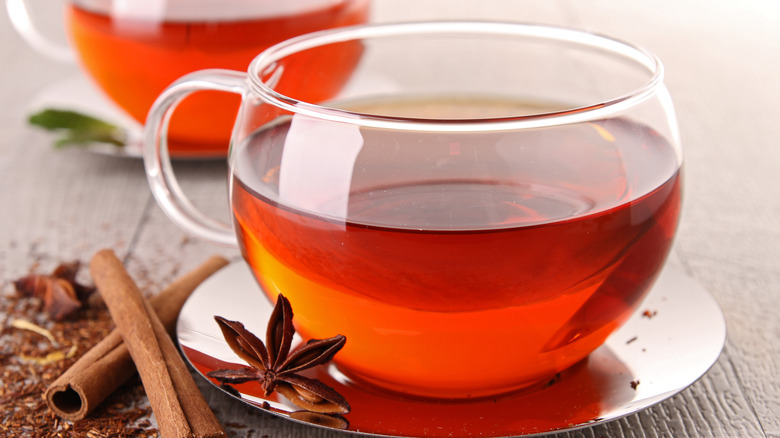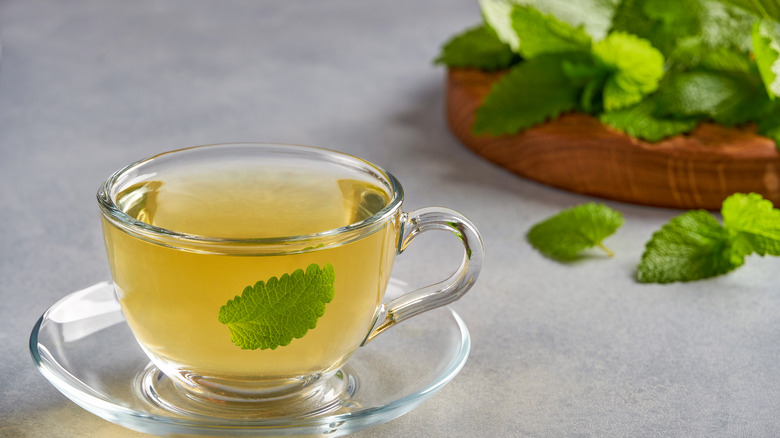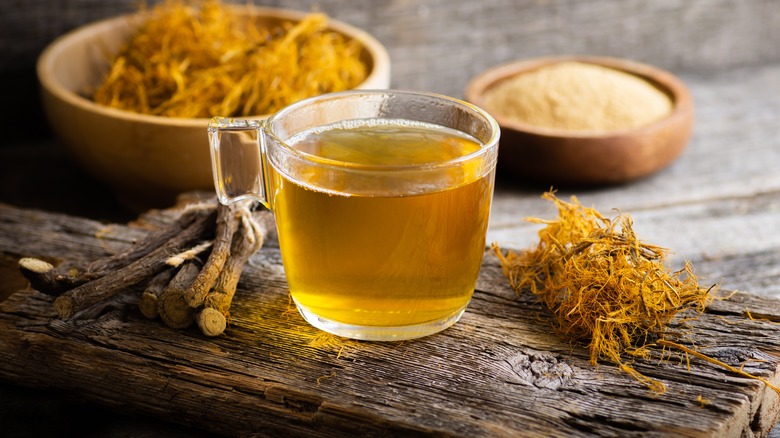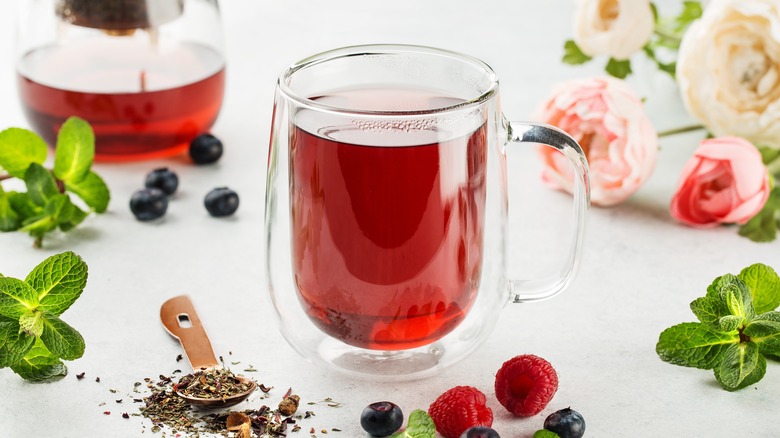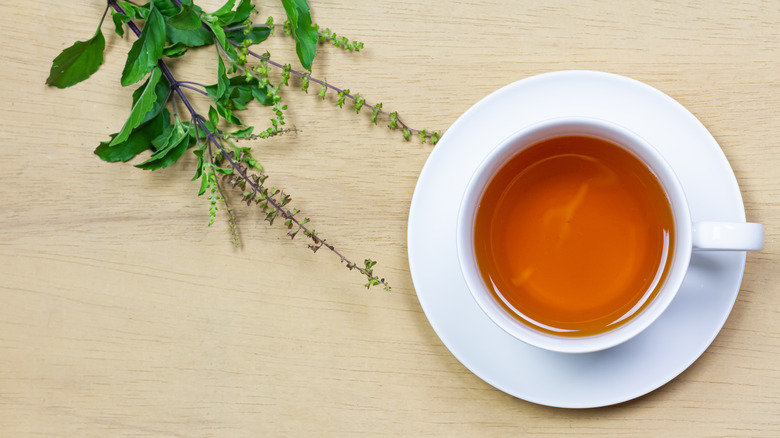23 Types Of Herbal Teas, Explained
Herbal tea, which many people request before they go to bed or when they are getting over a cold, is the perfect way to warm your body up without the zing of caffeine. However, perhaps calling herbal tea, tea, is in fact incorrect. The definition of herbal tea is that it is an infusion of various leaves, fruits, barks, and roots, which come together to flavor water. What makes herbal tea not actually tea is that is it not from the tea plant, Camellia sinensis. Camellia sinensis leaves are the base for all major types of caffeinated tea, which include black, oolong, green, white, and red teas.
So, although herbal teas may not be technically teas, they are still hugely beneficial for our bodies. Many herbal teas, made from leaves, herbs, roots, or spices, are rich in antioxidants and can ease digestion, or relieve mental and physical pain. Sounds pretty good, right? If you know which teas can help with which ailments, then you will be better equipped to combat your next cold or round of body aches. Keep reading to learn how these common herbal teas can help your body in specific ways and keep you feeling good.
Chamomile
The ultimate herbal tea, chamomile has a very subtle flavor that is comforting and the perfect bedtime drink. Chamomile tea comes from chamomile flowers, which have darling white petals and yellow, sunny centers. These flowers can be steeped in hot water when they are fresh, but if you want to have chamomile tea all year round, try drying them and storing them in an airtight container.
Chamomile tea is well known for its ability to help with relaxation, digestion, and sleep. On top of that, chamomile tea can help reduce inflammation and aid any indigestion by reducing acid reflux and combatting bloating.
Peppermint
Mint has a place in many elements of our food. Something about its bright, fresh flavor makes it incredibly alluring and a great addition to sauces, dips, and ice cream. But that is mint, and we are talking about peppermint. The difference between mint and peppermint is simple. Mint is an overarching name for all mint plants, while peppermint is a specific variety.
Peppermint specifically is known to help with digestion, ease migraines, and clear your sinuses. When brewed, the leaves also release a natural sweetness that combines perfectly with the minty freshness that this multipurpose tea is famous for.
Lemongrass
Lemongrass is not actually part of the lemon family or related to lemons in any way. Rather, the leaves of a lemongrass plant, which are long and slender, have a faint sourness and zest that resembles lemon in flavor and lends itself well to marinades and sauces. In addition to its gentle lemon flavor, lemongrass also has a distinctive green taste which is even stronger when the leaves are brewed fresh.
This tea, which goes well by itself or is equally as delicious mixed with other things like ginger, is great for your health. Lemongrass helps lower cholesterol, relieve pain, and prevent infection. Lemongrass tea and extract can also have very positive results in combatting anxiety and stress.
Ginger
Ginger, the ultimate aromatic, is wonderful dried, fresh, candied, pickled, and in so many other forms. This root, which can be spicy, sweet, and fragrant brings an irresistible zing to many soups, stir-fries, and smoothies. In its powdered form, ginger is an essential addition to our favorite desserts like pumpkin pie and gingersnap cookies. This multipurpose root will continue to surprise you, because, along with being delicious and comforting, ginger is also very beneficial for your health.
Ginger tea, ginger chews, drinks, and candies can relieve nausea or motion sickness. Along with being a good way to settle your stomach, ginger also helps manage blood pressure and is beneficial for your heart.
Hibiscus
What a beautifully rich and royal color hibiscus tea is. Also known as Jamaica, and often drunk as iced tea, hibiscus tea is a common agua fresca that is enjoyed across Mexico. This refreshing drink is a combination of hibiscus tea, lemon juice, and sugar, making it a sweet and irresistible drink, especially during a hot afternoon.
Hibiscus tea is made from hibiscus flowers, which are bright red, and almost purple when they are in flower. To make hibiscus tea, the flowers are dried until they are simply shriveled versions of their past beauty, and then they can be rehydrated in hot water. This way the tea absorbs all of the lovely tastes and colors of the flower, while also adopting its unique floral flavors.
Echinacea
Aside from having a name that is a bit difficult to pronounce, echinacea tea is delightful and comes from beautiful flowers. Echinacea flowers, which bloom naturally from the midwest all the way south to Texas, come in various shades, with the most popular being a light purple.
The purple flowers give off a mildly sweet flavor that has floral and grassy undertones. Echinacea tea also tastes slightly of straw and turns a pleasant golden red when it is brewed. Echinacea tea is also known to be an immunity enhancer, making it a great choice for the next cold season.
Rooibos
Rooibos tea is known for its dark color and rich flavors. It has been described as tasting earthy, slightly smokey, and floral, which makes sense considering that it is yet another herbal tea that comes from a flower — specifically, you may have guessed, from the rooibos flower.
Rooibos plants originate from South Africa, more specifically from the region of Cederberg, and all of the rooibos tea in the world is primarily grown there. Rooibos is fantastic as a nice herbal tea, but it also lends itself well to savory applications like rubs and marinades. On top of that, the nutty flavor of rooibos brings a perfect balance to cookies and cakes.
Passionflower
Perhaps you know passionfruit, and perhaps you love it. If so, there is a lot to love. Well if you are enamored with passionfruit, you may be slightly deterred by the similarly named, yet slightly differently flavored passionflower. Passionflowers are absolutely stunning. They have striking offshoots that surround the center like a little mane and are incredibly fragrant.
It should come as no surprise that passionflowers, along with being beautiful, are also delicious. Passionflower tea can reduce anxiety, ease menopause symptoms, and help with the quality of your sleep. Additionally, passionflower tastes great. It has a sweet floral flavor that is fantastic either hot or cold.
Rosehip
You can certainly make tea out of rose petals and buds, but another part of the rose plant that you can eat is the rosehip. Rosehips are small fruits that form on the rose plant, right at the base of its flowers. Rosehips, which are usually harvested in the fall after the roses have died, store very well once dried.
These little buds make fantastic tea that tastes slightly of roses but with more fruity notes. Rosehips are also a fantastic source of vitamin C, and according to WebMD, one 8-ounce cup of rosehip tea has 7.5 milligrams of vitamin C in it. While this may sound like a substantial amount for one cup of tea, compared to fresh rosehips, this is negligible.
Butterfly pea
What a beautiful tea this is. Butterfly pea tea is a great way to brighten your cocktails, dinner table, or evening cup of tea before bed. When the butterfly pea flowers are soaked in hot water, they transform into the most vibrant, dark blue color that borders on purple.
When you go a step further and pour some milk into your tea, the final cup is colored a delightfully creamy shade of baby blue. In addition to being absolutely stunning, butterfly pea tea boasts a lot of health benefits. It is great for your eyesight, combats inflammation, and helps stabilize your blood sugar. Altogether, the fantastic color of butterfly tea along with its impressive benefits makes it a great tea option to have around.
Lavender
The only way to describe the taste of lavender is to say that it tastes like lavender. This adorable purple flower that is world-renowned has such a unique smell and flavor that describing it simply as floral would not be enough. Lavender, with its darling purple buds and irresistible taste, is a wonderful option for a cup of tea.
Not only famous for its looks, lavender tea is also very well known to have many benefits. Among the most prominent is lavender's ability to ease anxiety and stress. Whether you are smelling a lavender sachet, using lavender essential oils, or sipping on lavender tea, lavender is a great tea option for when you are feeling on edge or cannot get your brain to stop chirping.
Barley
Another fantastic iced tea option, barley tea is the ultimate summer drink. With absolutely no sugar needed (or even recommended), and it is simply enjoyed as is, barley tea is refreshing, simple, and delicious. Usually roasted and then dried, barley tea has notes of nuttiness from the barley that infuse into the water in a wonderful way.
The nuttiness of this tea is reminiscent of other roasted teas like hojicha, but with all of the flavor and none of the caffeine. On a hot summer afternoon, there is nothing as delightful as a tall glass of this cooling and rejuvenating tea.
Cinnamon
Cinnamon, best known for its role as one of the ultimate warm spices, can actually be quite spicy. When sipped just by itself, cinnamon tea without sugar or milk can clear your sinuses and bring a welcome yet gentle fire to the back of your throat.
You probably know what cinnamon tastes like, but it is remarkable how much milder the taste of something is once you add sugar. Just plain cinnamon is vibrant and earthy which makes it the perfect winter tea. In fact, there are so many varieties of cinnamon that you can shop around until you find one that is the perfect combination of sweet, spicy, and warm.
Dandelion
Dandelions are very multipurpose plants, so it is a real shame that they are so invasive and difficult to remove from a lawn. If you can get past their peskiness, hopefully, you can see dandelions for the delicious and versatile plants that they are. In addition to being able to eat dandelion leaves, you can also eat its flowers.
You can eat the flowers in a variety of ways. They are great in tempura or mixed into cookie dough, but one of the simplest ways to use dandelion flowers is in tea. You can dry the flowers so that they are shelf-stable, or you can steep them while they are fresh and plump. Either way, dandelion tea is known to be anti-inflammatory and help with cholesterol, making it an incredibly valuable weed.
Chrysanthemum
Another plant that you can eat both the flowers and the leaves, chrysanthemum tea is absolutely divine. With such a delicate flavor that comes from delicate flowers, chrysanthemum tea is a must-have. If only to look at the cute flowers floating around in your cup, make sure to brew a cup of this wonderful herbal tea when you have a chance.
We recommend using chrysanthemum tea as a way to regulate your heart and immune system. Additionally, it is known to help keep your skin and mind clear — chrysanthemum tea is great for helping with relaxation and reducing anxiety.
Lemon balm
Lemon balm can often be confused with lemongrass or lemon verbena, but it is a separate herb. Lemon balm is actually part of the mint family. The way you can tell this is by feeling its stem, which is shaped with the same distinctive sharp, square edges as a mint stem. Somewhat similar to mint, lemon balm also has scalloped edges that can look feathery and soft; this is especially apparent the larger the plant.
Lemon balm is also a type of herbal tea that can be brewed more than once. This means that after you do one infusion from a set of leaves, you can use them one or two more times to make more cups. With each cup, the flavor of the tea will change. How it changes all depends on your technique and end goal in mind.
Jasmine
Jasmine tea is often mixed with green tea as a gentle flavoring, but these fragrant white flowers can be a tea all by themselves. The jasmine plant has small white flowers which have a big bright scent. These flowers are the key to jasmine tea, which is enjoyed all over the world in both its hot and cold form.
Jasmine tea, along with its delicious flavor, also comes along with many health benefits. It is prized for its ability to boost your immune system and bring mental clarity. On top of that, jasmine tea is a great option when you are having indigestion, and if you ever find yourself with an upset stomach at the same time, try adding in some ginger for a double hit.
Licorice root
Licorice root tastes very specific. And it's no surprise that it tastes like licorice. Some people love it, and some people don't. Regardless of if you love this flavorful root, licorice root tea is very good for you. Like licorice candy, licorice root is also very good for your digestion and can help regulate any stomach or gastrointestinal troubles that may be bothering you.
Licorice tea is great for your skin and teeth and can help minimize the impact of the everyday head cold. With its unique minty and spicy flavor that also tastes somewhat like anise, licorice root tea is great, especially when paired with something sweet and buttery to cut through the licorice flavor.
Chicory
Chicory tea is often enjoyed mixed with either cocoa powder or instant coffee. The combination of these powders makes chicory drinks nutty, earthy, and comforting. If you are looking for plain chicory tea without sugar or caffeine, then try making it solely from chicory root.
Chicory root is a strong digestive aid and can help with constipation and bowel movement. It also is a great tea option for those looking to go on a cleanse, especially a cleanse of the liver. It does this by reducing oxidative stress to the liver and improving the overall well-being of this important organ.
Raspberry leaf
Raspberry leaves are certainly not the most famous product from the raspberry plant. In fact, you may be surprised that you can even consume the leaves of this spiky green bush, but the truth is out. You can, and, moreover, they are very good for you.
In fact, raspberry and blackberry plants have similar benefits. The most significant of which are helping relieve menstrual cramps and easing digestion. These super leaves can also ease pain in the late stages of pregnancy and help regulate menstrual flow by strengthening the uterus which eases blood flow and even assists in childbirth.
Turmeric
Turmeric is a spice that has the rich golden color of the sun. Available in powdered, dry form, or in fresh little root nubs that resemble ginger, turmeric is a superfood and super versatile. Turmeric pairs well with rice, meat, and veggies, and also brings in the added pizzaz of color. Everything that has turmeric in it turns a warm, deep yellow which makes this spice not only very good for your body, but pleasing to the eye.
So how is turmeric so good for you? This spice has many benefits such as helping with inflammation, strengthening your immune system, and bringing mental clarity. Next time you are looking for a multipurpose tea to calm your mind and muscles, give turmeric a try and you will be pleased with its earthy, comforting taste and wonderful benefits.
Tulsi
Tulsi tea, which comes from the holy basil plant, is a type of tea renowned for its health benefits. This tea tastes slightly of basil, but with more astringent notes, especially depending on how long you brew it for. Tulsi tea is known as one of India's most important teas due to its healing properties.
These healing properties include bringing mental clarity, easing stress, and boosting the immune system. Tulsi tea is so valued for its positive effects on the body that it is a highly valuable and sacred herb that is used as a preventative and prescribed medicine.
Fruit
The last herbal tea on this list is another category in itself: fruit. While the definition of herbal tea is that it comes from a plant and does not have caffeine, fruit confusingly fits into this definition, but is also a whole category on its own. That is because fruit teas vary just as widely as fruit varieties vary themselves, which is a lot.
You can make cranberry, orange, raspberry, and even gooseberry tea, simply by soaking fruit in hot water and letting the flavor infuse. Each fruit has its own flavors and health benefits, so it makes sense that each fruit tea also has as much variety. While there are too many fruit teas to dig into in this article, they are still worth a sip and we hope that you take the time to brew yourself a cup.
Static Media owns and operates Tasting Table and Mashed.





